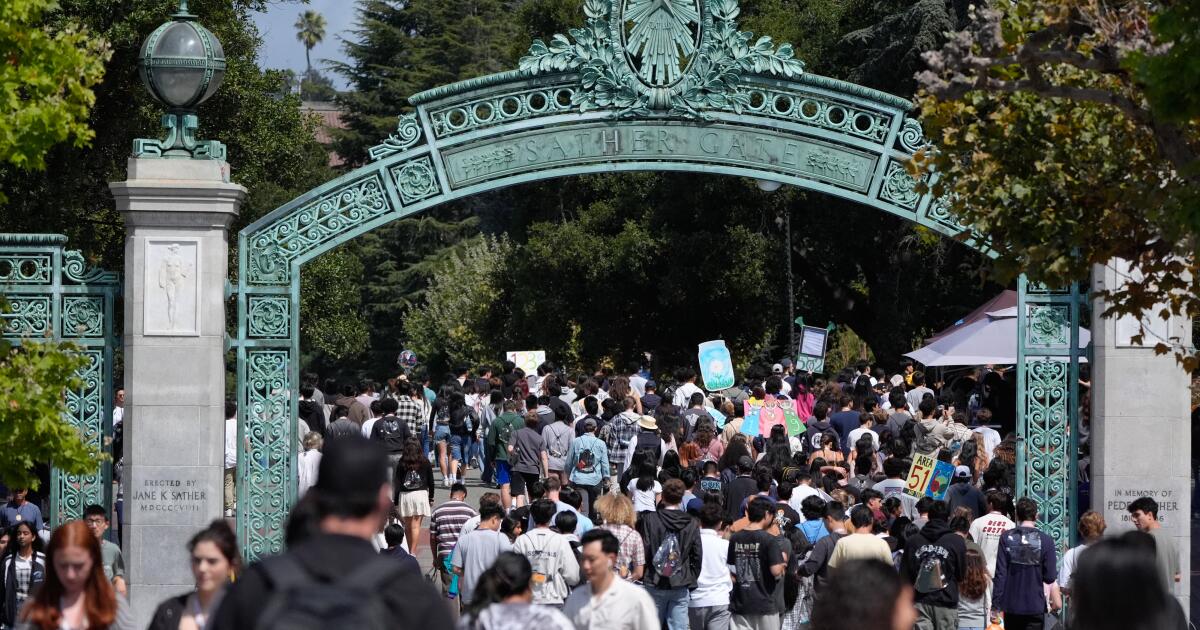SACRAMENTO — Atop my Christmas wish list is free tuition for all California undergrads at public universities. We had that for generations before shortsighted politicians took it away.
No, I’m not advocating a free college education. Tuition accounts for only a third or less of what it costs to attend the University of California or a California State University. There’s also room and board, books and supplies, and endless fees.
So, except for those on a free ride — such as star athletes or the poorest students — practically everyone would still have some “skin in the game” even if there was no tuition. College wouldn’t be a freebie.
Right now, annual tuition for an undergrad at a University of California campus is $14,934 — with total school costs running around $45,000, according to UC. Tuition is significantly cheaper at a CSU school: $6,084, plus average fees of $1,880.
Those are terrific bargains compared to costs at public universities in most other states — let alone at private institutions such as USC and Stanford.
But for middle-class families, tuition in high-cost California often requires a financial stretch. And it’s an incentive for a kid to skip college and just grab some dead-end job.
I was prompted to write this because of a question tucked into a recent poll by the Public Policy Institute of California.
California adults were asked what they’d think of making tuition free at public colleges. They favored the concept by nearly 2 to 1: 66% to 34%.
Free tuition was supported by virtually every demographic group, with one exception: Republicans. They opposed it 2 to 1. But it was supported by Democrats 5 to 1 and by independents nearly 3 to 2.
It was favored by 73% of people with only high school diplomas and 63% of college grads.
“When people talk about things being too expensive in California, one thing that always comes up is the cost of higher education,” says PPIC polling director Mark Baldassare. “People ask, ‘Is it worth it to go to college?’”
He adds: “There was a time when having a high school diploma was the only ticket needed to the middle class. But today that’s harder to do.”
A response to another poll question should especially alarm policymakers. People were asked whether they thought “the American Dream — if you work hard you’ll get ahead — still holds true.”
Only a third said it did. Slightly over half said it once held true, but not anymore.
“If anything,” Baldassre says, “people are saying that it’s harder in California to achieve the American Dream. That’s because of the cost of living.”
Of those surveyed, 62% felt the American Dream was more difficult to attain in California than elsewhere in the country.
And 56% said California is headed in the wrong direction.
So, California has come full circle from the last century — particularly since the Great Depression and post-war boom — when Americans flocked to the Golden State for a better life.
One benefit they discovered was free tuition at all public colleges. It enabled kids like me from struggling households to become the first in their families to attend college — even graduate.
I recall former Assembly Speaker Anthony Rendon (D-Lakewood) once telling me: “I was a product of California’s low-cost higher education. But I don’t know that I would have thought of college as an option today” — because tuition has soared.
Historically, California policymakers regarded tuition-free college as a sound economic investment. It wasn’t some feel-good social program. It was in the state’s self-interest to produce college-educated innovators and skilled professionals to grow the economy. The middle-class expanded, with people landing good-paying jobs that resulted in higher tax revenues for state coffers.
But the state switched priorities in the 1970s and began spending its money on other stuff: enhanced welfare, healthcare for the poor and — especially — K-12 schools to compensate for lost local property tax revenue after voters passed Proposition 13 in 1978. These days, there’s also the still nonexistent, so-called bullet train.
Tuition crept onto campuses in the 1970s and steadily grew.
Today, tuition and fees generate $4.3 billion annually at UC, the state Department of Finance says. At CSU schools, it’s $3.4 billion.
If you mention to politicians the potential benefits for California of returning to free tuition, they roll their eyes and claim the state can’t afford it. Rubbish. California could afford it for generations. And the fifth-largest economy on the planet could afford it today with smart prioritizing.
Naysayers — especially university leaders — point out that many kids from low-income families receive grants, scholarships and student aid. But wait!
What they don’t like to acknowledge is that tuition-paying students fund the aid. Their tuition is hiked to pay the fare for needy students. That’s unfair. If the aid is good public policy, the entire public should pay for it.
In fact, if tuition was free, the state could save $2 billion annually in Cal Grants that cover the tuition of needy students.
Students get the best bang for their buck at community colleges. There, full-time, first-time students who are California residents aren’t charged course fees. This should extend to all California students working toward a degree, full-time or not.
If university tuition was free for undergrad California residents, it could motivate financially pressed families to stay put and not flee the state. It also could entice middle-class professionals to move to California — once again seeking a better life.
But I’m a realist. This gift isn’t going to arrive anytime soon.
It’s a good issue, however, that a smart candidate for governor could grab and ride into the state Capitol in 2026.
